The construction of a billiard table
THE CONSTRUCTION OF' A BILLIARD
TABLE
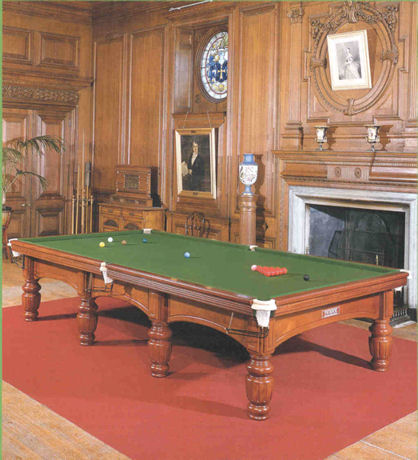
A THURSTON
'International' modelBilliard/Snooker
table
Most full sized Billiard tables stand on 8 legs. I think however
we should perhaps immediately recognise that the legs and under
framing of a Billiard Table are really only the physical means of
supporting the playing surface at a convenient height above floor
level.
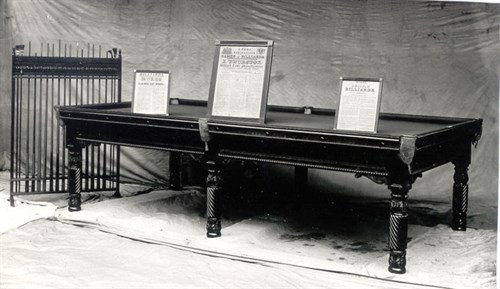
Picture of an old wooden
bed THURSTON Billiard Table
In the past some full sized Billiard Tables were made with only 6
legs whilst others were made with 12 and more legs. By and large it
seems that the most convenient arrangement which enabled the table
to stand firmly, and to be levelled up accurately, was a table
standing on 8 legs.
The timbers most commonly used for the manufacture of Billiard
Tables are probably Mahogany, Oak and Walnut but other timbers have
been used with complete satisfaction.
In the early part of the 19th century, the bed of the table
itself was also made of wood. The beds were usually made in three
sections, and I have with me for your inspection a complete wooden
bed of a full sized table in three sections. As you will see, it is
in really very good condition for its age.
Each section of the bed comprises a
frame made in Oak, into which tongued and grooved hardwood blocks
have been fitted in panels rather like a modern wood block
floor.
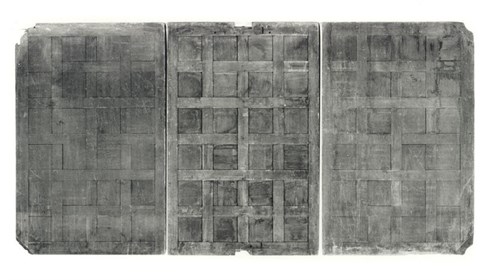
Note however that the grain of the timber in the neighbouring
panels runs in the opposite direction to each other. This being
done to minimise so far as possible the effect of warping. Even so,
it was frequently necessary to send skilled Billiard Table Makers
to the customer's premises to plane over, and level the bed of the
table using hand tools.
I understand from my father (Norman's father E.A. Clare), that
this was generally referred to as "flogging the bed".
Written records are still available in sales ledgers belonging
to Thurston & Company Limited, of which the following examples
can be quoted:
"12th February 1825 The Travellers Club. Taking off the
cushions and the cloth -planing over and levelling the
bed."
"2nd. November 1826. Letting in several pieces into the bed
planing the bed and finishing complete".
Clearly therefore wooden beds did present a considerable
problem, although I do not suppose that any of them were even
reasonably level.
However, so far as I have been able to ascertain, the actual under
framing and legs of the Billiard Tables which were fitted with
wooden beds, were not all that different from the under framing on
Billiard Tables of traditional design, which are still being
manufactured at this present time, and so before we look at the
introduction of other types of bed, including the new universal
slate beds, let us quickly look at the construction of a Billiard
Table under frame by referring to the model which I have brought
with me for this purpose(shown
below).
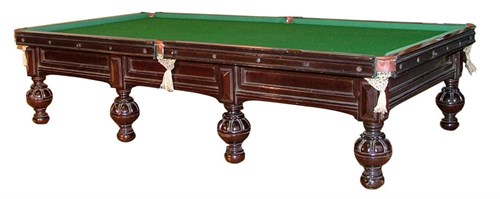
The replica of the Leicester
Square Match billiard table that Norman used is only 3ft
long
First of all we have the 8 legs to
which I have already previously referred. We generally call 4 of
the legs "corner legs" and the other 4 "middle legs".
Then there are 2 long side rails which are bolted to the corner
legs at one end of the table, passed through the leg squares of the
middle legs on each side of the table., terminating and bolting to
the corner legs at the other end of the table.
Similarly we have 2 end rails, which are bolted into the corner
legs at each end of the table.
Next there are 2 middle rails which transverse the table from
side to side, being bolted into the middle legs.

Then the commonest form of construction includes a number
of bearers or muntins which are fitted by mortise and tenon, or by
dowel joint, between the middle rails and between each middle rail
and the end rails. Some tables of old design will have as many as 9
bearers/muntins. Generally the majority of tables have 6. The most
recently constructed have only 3. One particular design of table
however, made by Burroughes and Watts does not have any
bearers/muntins, instead there are two additional middle rails on
adjustable supports to assist in levelling the table.
(Similar adjustable supports are now used for the bearers
on most modern tables rather than using mortise and tenon or
dowels)
It will be realised that when Billiard Tables were fitted with
wooden beds the larger the number of bearers/muntins the better it
would be for holding down the wooden bed and keeping it as true as
possible. Clearly, the upper edges of the side rails, end rails,
middle rails, and bearers, all had to be perfectly level with each
other for this purpose. This was also necessary when the original
slate beds were introduced, as they were rather thin by modern
standards, and as a thin slate can easily "sag" and become hollow,
or if one bearer was standing proud, the slate would become
"rounded". It was always part of the skill indeed considerable
skill, of the Billiard Table Maker to ensure that the under-framing
itself was perfectly true.
However, before we consider the introduction of other types of
bed, I should also mention that the under-frames themselves
sometimes were made of other materials. If you care to visit
Penrhyn Castle, Bangor in North Wales, there you will find a
Billiard Table of which the entire under frame is made of slate.
This is not perhaps surprising, as most of the original slate beds
came from Penrhyn Quarries, so no doubt Lord Penrhyn himself
decided that the entire billiard table would be made of slate.
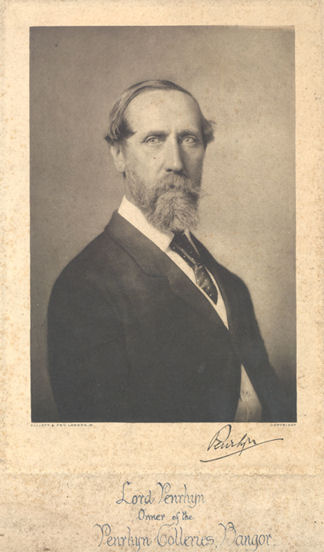
Lord Penrhyn
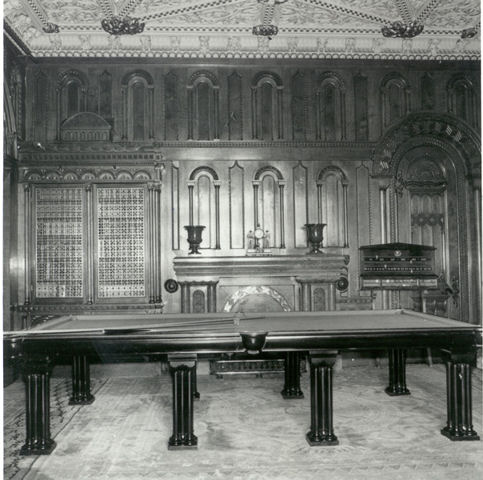
Slate Billiard table in
Penrhyn Castle, Bangor, North Wales
To my own knowledge two other full sized Billiard Tables, with
under frames made entirely from slate, existed in Capel Currig in
North Wales. As a young man when serving my time to Billiard Table
Making, I was taken by one of our travelling billiard fitters to
the club where these tables were installed. He himself had had the
job of moving them some years earlier, and he took me to see them
because of their particular construction. Years later, following
the second world war, I again came across these two Billiard Tables
in store - they had been dismantled when the Institute was closed,
placed in store in Capel Currig - we received a message inviting us
to inspect and make an offer for these two full sized Billiard
Tables. I expected to find two tables of normal construction with
wooden frames, indeed I had really forgotten all about the tables
with the slate under frames. When I came to inspect them, here once
again were the two Billiard Tables with the under frames and legs
entirely made of slate, and so of course I flatly refused to
purchase them.
Billiard Tables were also made in Liverpool during the second half
of the 19th century by a firm called Marsden and Saffley, in which
the under-frames were entirely made of Cast Iron. These tables
stood on 6 legs only, and I have with me an actual photograph of
one of these under-frames, and you will note the Liver Bird
borrowed from the Liverpool Coat of Arms has been cast into the end
rail. One of these tables existed in the Tate and Lyle Staff
Recreation Club in Liverpool until a few years ago, when on our
advice it was scrapped. (Norman later regretted
that he had not obtained the table for his collection. In 1998
Norman's son Peter was delighted to accept a donation of a cast
iron table frame to the collection. However it wasn't a Marsden
& Saffely but from a London firm called Harris
& Sons - see Article 'Cast Iron Billiard Tables' See also
article on a Marsden & Saffley
Billiard table on display in Thurston Liverpool
showroom)

Picture shows the cast iron
under-frame of a Marsden & Saffley Billiard table
Note Liver Bird motif cast into
end rail
I also have with me for your inspection a Sales Leaflet
published by Marsden and Saffley, containing testimonials as to the
quality of their Billiard Tables, and so it is that you will note
their tables were also fitted with patent composition beds. In
these days we would in fact call them "Concrete" beds. You will
note that they claim that wooden frames and slate beds are now
entirely superseded, only the wooden cushion rails being
retained. (We have a concrete bed from this period
in the collection, which we believe came from a Marsden &
Saffley table. It was found in the old Ashcroft & Co. premises
in Victoria Street, Liverpool .The bed has another unusual feature
in that the sections have tongue and grove joints and bolts that go
through from the end slates to the middle slate to 'bolt' the bed
together)
We must now go back in time to the actual introduction of the
slate beds, but before doing so I will just mention that some
Billiard Tables were also fitted with beds made of Iron - such
tables existed in Ireland where my father erected a number of them
at the beginning of the 20th Century - he came across them during
the years he worked in Ireland from 1902 until 1912. I understand
that considerable difficulty was experienced when installed in a
damp room atmosphere - the bed of the table would of course develop
rust, and the rust would stain the cloth. Great difficulty was also
experienced in releasing rusted nuts and bolts used for the
assembly of the Billiard Table.
I have also heard about Billiard Tables being fitted with
beds made Float Glass, but this is only hear-say, although it is
quite true that very recently Pilkingtons of St. Helens did
approach various members of the Billiards Trade in order to try and
ascertain whether their new "Float Glass" could be used for
Billiard Table Beds (in fact they did produce UK
pool table beds in glass, which Rex Williams Leisure used in their
tables for a short period but it wasn't successful. An example of
such a bed, from a later trial is in the
collection).
It would seem that the first slate beds were introduced by John
Thurston somewhere about 1826, when the first reference can be
found to an "Imperial Petrosian Billiard Table" and it seems that
thereafter nearly all the tables manufactured were fitted with
slate beds.
As I mentioned earlier, the original slate slabs were rather
thin, generally being about 1" thickness, and thus as slate is in
fact quite flexible, it was necessary to have at least 9 bearers in
the supporting frame work, and it was essential that the bearers,
end rails, and middle rails, and side rails, should all be
perfectly level with each other. If a table was badly erected by an
unskilled person, so that the bearers were not level with the side
rails, then the slate bed would go out of shape - in practice this
generally meant that the slate bed became "hollow" from side to
side across the table. Thus, as time went on the practice of using
thicker and thicker slate beds was followed, and for the past 60/70
years it has been generally accepted that a slate bed should be
somewhere about 1 ¾" - 2" in thickness if it is going to be
satisfactory. The thicker the slab the heavier it becomes, with all
the attendant difficulties of moving a Billiard Table, especially
if it has to be carried up or down stairs. So I am sure you will
understand that as each slate slab weighs somewhere between 3 ½ - 4
cwt. it requires four men to handle it safely. Thus four men are
required whenever a Billiard Table has to be erected, dismantled
removed etc., and so it is now a very expensive operation.
There is still nothing better in sight than a slate bed
for the surface of a Billiard Table. Slate has the advantage that
it is reasonably easy to cut, and to drill and to plane the surface
true. Unfortunately, even in the course of careful handling of the
slate slabs, some small pieces may be chipped off edges, however it
is reasonable easy to repair the damage using modern filler
materials, whilst minor damage can be easily filled in using a fine
quality plaster of paris. Clearly, it would be much more difficult
to cut/drill or otherwise work concrete beds, glass beds, or
iron/metal beds, therefore it would seem that we will have slate
bedded Billiard Tables for a long time yet.(In the
mid 1980's during a brief boom in the manufacture of snooker
[billiard!] tables slate was in short supply. Various companies
tried 'modern' resin materials but none proved to be as good or as
economic as slate)
© Norman Clare 1990. © E.A.
Clare & Son Ltd. 2018/19/20.
Reproduction of this article allowed only with the permission from
E.A. Clare & Son Ltd.
www.thurston.co.uk
to contact us by phone
0151 482 2700
or
email - thurston@eaclare.co.uk
copyright E.A. Clare
& Son Ltd 2009. & 2011
Go to top of page

